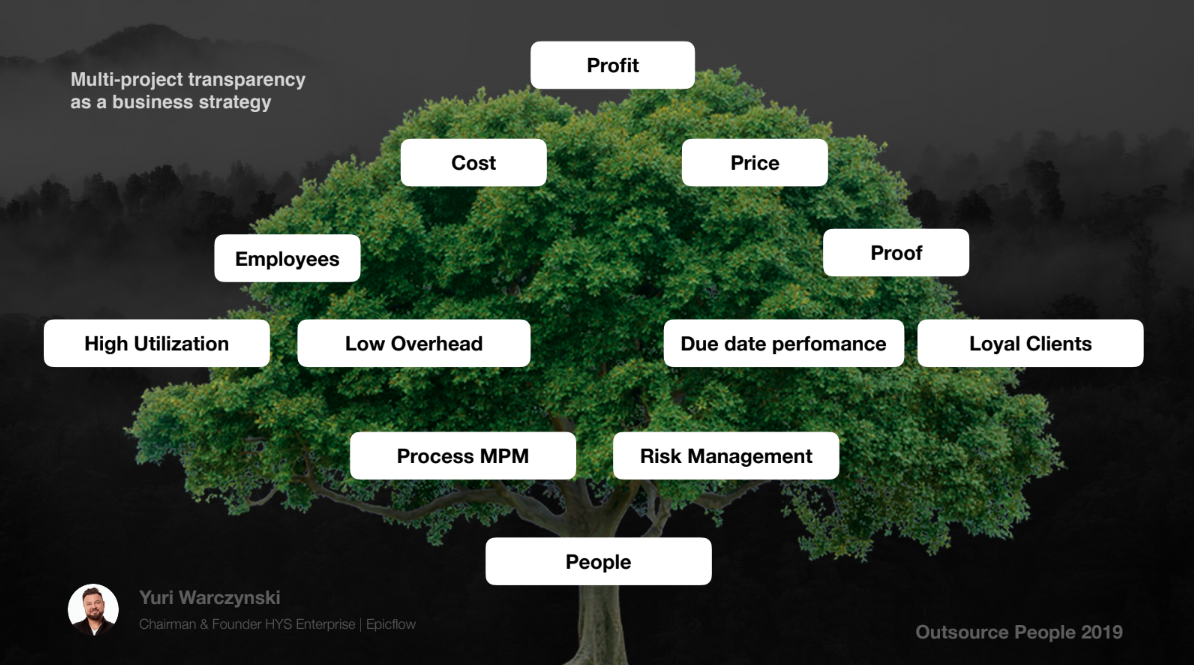We glad to put down here the key ideas shared by Yuri Warchinsky, CEO of HYS Enterprise and multi-project evangelist at Epicflow, during his speech at Outcourse People conference in Kyiv, on October 12-13. It can help you to analyze how effectively you distribute your resources and why bottlenecks occur on different stages of your project execution.
1. Transparency as a Business Strategy
What is transparency? This is clear, unhindered honesty and lack of hidden agendas or conditions. Let’s look at how it affects business strategy and helps a company.
To gain profit now and in the future, we need sales, expense control, loyal employees and customers. Loyal customers recommend you to other people and help your business grow. Loyal employees are the foundation of your company. Losing one loyal qualified employee can cost a lot for a company.
What is necessary for sales? We should prove our expertise in what we are doing and show the value of our company.
Saying about expenses, we need a low overhead. We could achieve that thanks to the transparent processes without a vast hierarchy. The second significant point to consider is high utilization. When we deal with a multi-project environment, it’s hard to see the number of working combinations, but transparency can help with it. We’ll talk about it further.
To sum up, the perfect picture of proper internal processes leading to the profit includes all such components as high utilization, high projects performance, loyal employees and clients. You can look at it in a tree-form on the picture below.

2. Multi-project Management Transparency
Let’s dig deeper into the multi-project management process. The Gantt chart was invented 100 years ago, but only in the 60s, a critical path appeared. It took 40 years to develop such a simple thing. We’ve created a solution that seems uncomplicated but requires in-depth research into multi-project management. First of all, a successful multi-project process needs a pipeline. Let’s look at how it should work for an employee, manager and C-level.
Employee
Each employee should have priority tasks. We can calculate all dependencies between the tasks and create the best way to solve them. But the employee has to describe their working process, know about the tasks of other colleagues, what is done or remaining for all projects of their resource group. That is transparency at the task level.

Manager
At the management level, it is necessary that the loading by group resources is transparent. This should be visible to other managers, as others may be overloaded. We need a transition from one project to another. For example, we asked our employees who were ready to switch between tasks, and it turned out that 20% were ready for it. For successful multi-project management, it’s enough if 10% of people are prepared to do it. You just need to find them on your team.
So to keep transparency at the management level, the manager should provide such indicators as team performance and overload or underload of their resource group.

C-Level
At the C-level, you need to know the ratio of the remaining buffer to the remaining time. Each project has a buffer. For example, we started the project and set up the 30% buffer. Half of the project has passed, and only 5% of the buffer remains. You can guess that this project won’t be done on time. Keep abreast of this ratio to avoid the rush and overdue projects.

3. Common Mistakes in Multi-Project Management and How to Avoid Them
This approach may seem reasonable and effective, but it works not in all companies. So we asked those that were unsuccessful with it and got the following results.
At the employee level, they share only partial information when it makes sense for them, or even create overestimates to remove stress from stakeholders. In most cases, it results in student syndrome when the team have a lot of time, and a process is extended. Parkinson’s law also takes place in such a situation. It means that work expands to fill the time available for its completion. Anxiety is the core of this. In other words, the employee feels better to overestimate the task than catch hell from the boss. It leads to the high cost of a project.

Let’s go to the managers. They share resources only when it benefits them. Managers do not want to share resources because they are afraid to stay without the necessary stuff. This results in low utilization. And again, the root of this situation is anxiety.

Successful companies have a completely different environment – a culture of trust and mutual respect. The most valuable thing is trust. Allow your employee to express different points of view. Your team should have a common goal and be in the same boat.
So focus on the following things in your company:
- Common vision and values
- A structure that allows you to control from the macro level, and not from the micro level (evaluate the results)
- Collaborative process
- People who can disagree without disagreeable (no blaming and shaming)
These points will help you to establish a transparent and productive background enabling you to grow. Feel free to get in touch with us for any questions. We will be happy to assist with building efficient multi-project management environment.
